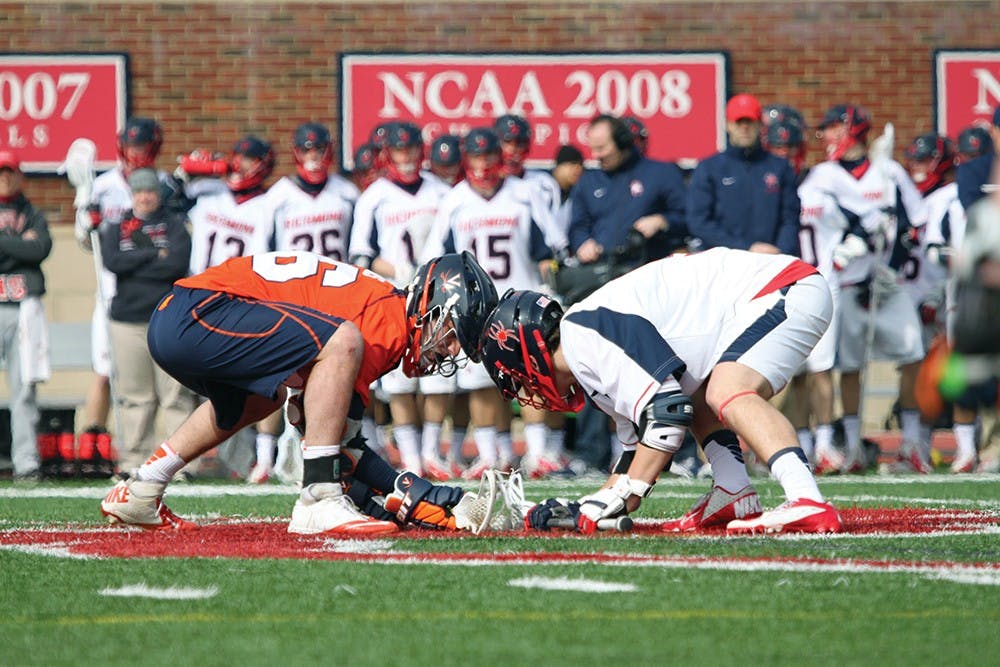The University of Richmond played its first-ever NCAA Division I men’s lacrosse game Saturday, as 4,249 fans packed Robins Stadium in Richmond, Va. to watch the Spiders host No. 7 Virginia. The crowd was representative of the sport’s rapid growth in the United States in recent years.
Athletic participation is down nationally. The four most popular team sports in the U.S. have traditionally been baseball, basketball, football and soccer — sports that saw 7.2, 8.3, 5.4 and 7.1 percent declines in participation from 2008 to 2012 among youth aged 6 through 18, according to the Wall Street Journal.
But lacrosse appears to buck the trend. Over the same time period, the sport saw a 158.1 percent increase in participation — a stark contrast to the prevailing notion that kids are spurning athletic activity for more lethargic pursuits.
“Lacrosse is booming in the state of Virginia — there’s no reason to think that Richmond won’t be really good quickly,” Virginia coach Dom Starsia said. “And I think that’s a sign to other athletic directors and administrators around the country that if your institution is built like Richmond’s, then this is a sport in which you can be successful in the springtime.”
Despite the increase in numbers at the youth and high school levels, college athletics has been slow to respond. From 2008 to 2012, men’s lacrosse teams increased by 23.4 percent NCAA-wide, but by a mere 8.9 percent at the Division I level.
“I really am proud to be part of christening this program,” Starsia said. “I welcome Richmond’s addition of men’s lacrosse. We need more collegiate programs.”
There are currently just 63 Division I men’s lacrosse programs. Three schools in the state of Virginia offer Division I men’s lacrosse — Virginia, Richmond and Virginia Military Institute — while only six of the ACC’s current 15 member institutions — including outgoing Maryland — field men’s lacrosse teams. All three are numbers that Starsia would like to see go up.
“When I look at Virginia Tech and James Madison, they would be great lacrosse schools,” Starsia said. “If you want to be a presence in the spring in a sport that’s captured the attention of ESPN and people in the Northeast, it’s men’s lacrosse. In Tech’s case, they’d have the best schedule in the country the first year. So I hope the people at Tech are watching this and decide for themselves, ‘Hey, I think we want a little piece of that.’”
Starsia’s hopes are not too far off — the game has certainly caught the eye of other Virginia universities.
“There’s not a month that goes by that I don’t get an inquiry from someone about the possibility of adding men’s lacrosse,” James Madison Director of Athletics Jeff Bourne said. “I tell them that although I think we could be successful with it, financially right now and where we are with Title IX, it doesn’t make sense to add it.”
Title IX is a federal statute which requires relative parity between the men’s and women’s athletics offerings at institutions receiving federal education funding.
“We wouldn’t just be adding just one sport,” Bourne added. “We’d be adding more women’s sports to balance it. It becomes a pretty expensive venture when you look at it.”
Bourne said that though the school acknowledges it is in a great area for men’s lacrosse, there are several considerations that go into adding a sport. These include the program’s potential to succeed, compliance with Title IX and many costs beyond the program’s operational budget — including academic assistance, sports medicine, strength and conditioning and athletic facilities for the new team.
Indeed, Richmond’s program did not come without a hefty price tag. On top of the monetary costs, the Spiders cut men’s track and field and men’s soccer to add their lacrosse program — the only way to add a men’s team without an offsetting increase in women’s participation.
However, athletic directors around the country are far from clamoring to cut sports — men’s or women’s — due to the potential to disenfranchise alumni donors and fans, as well as current student-athletes whose programs are being eliminated.
With limited resources to add and support new programs, as well as a reluctance to eliminate existing teams, the status quo will largely go unchanged. Growth at the collegiate level will likely continue to lag behind increases in high school and youth participation.
Bourne said barring unforeseen circumstances, the Dukes will not likely add a men’s lacrosse program any time soon.
“In my opinion, you’d almost have to have a change in the legislation right now… and I don’t see that as a reality,” Bourne said. “And with all the pressure that’s on athletic programs now for funding, you’re asking for one more element to be funded, which is challenging in and of itself.”
But the biggest hurdle to adding a men’s lacrosse program did not involve finances or Title IX compliance, according to Richmond coach Dan Chemotti, it was waiting for the first game.
“The fact that we don’t have to wait 15 months to play another game is the best news I’ve heard all day,” he said.







